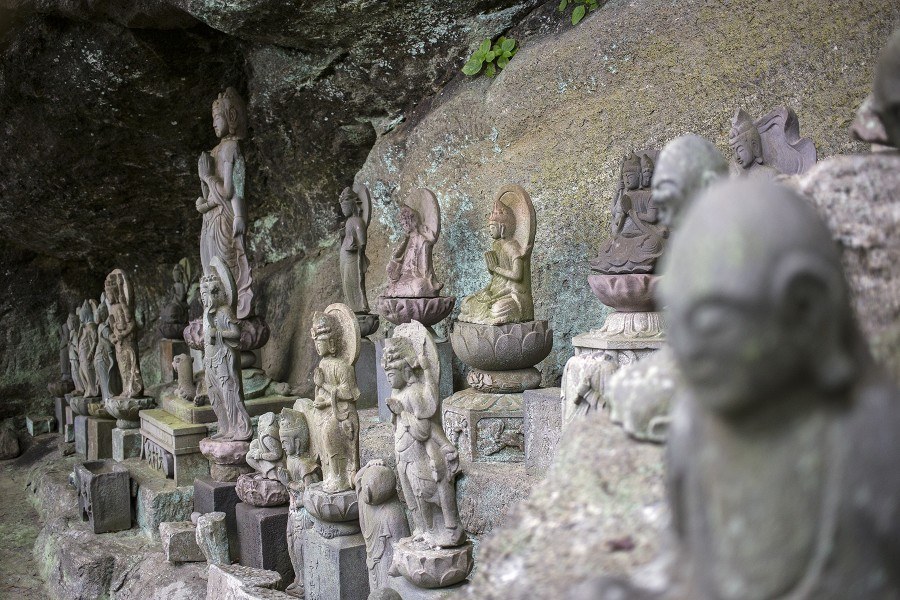Like this post? Help us by sharing it!

Don’t let the fact that few have heard of Nokogiriyama, and even fewer visited, fool you into thinking “Saw Mountain” isn’t an excellent option for a day trip from the Tokyo area.

Located across Tokyo Bay on the Bōsō Peninsula (Chiba Prefecture), a little over an hour from Yokohama and closer to two from Tokyo, this mountain derives its name from its resemblance to a Japanese woodworking saw, or nokogiri. It used to be a stone quarry during the Edo period, and the excavation of rock is partly responsible for giving the mountain its unique appearance.

The main attraction is Nihon-ji, a Buddhist temple that traces its history back to the Nara period, about 1,300 years ago. This is where you’ll find Japan’s largest stone Buddha, which used to be the largest figure of Buddha anywhere in Japan until the completion of Aomori’s bronze statue in 1984. Entrance is ¥600, and you’ll also receive an English map and description of the sprawling temple grounds.

The Hyakushaku Kannon is an impressive relief of Kannon, a bodhisattva and goddess of mercy, carved directly into a quarry wall. Hyaku means one-hundred, and shaku is a traditional unit of measure in Japan (and East Asia, although not uniform), the average length between nodes on bamboo, or approximately one foot.

The 1,500 Arhats are smaller statues of spirits or beings that have attained nirvana. They were chiseled from special stones sent by sea from Izu. The enormous task took master artisan Jingorō Eirei Ōno and his 27 apprentices 19 years to complete. Unfortunately, many of the masterpieces were destroyed in the anti-Buddhist movement of the Meiji period, but there are current efforts to restore them to their former glory. Still, among Buddhists, Mt. Nokogiri is widely regarded as one of the holiest mountains in the Kantō area; some even say the world, though I suspect they have a Bōsō bias.

The views from the cliff faces out over the bay are breathtaking, and you could easily spend a couple of hours visiting the different sights of Nihon-ji.

Standard footwear is adequate, but do be aware that there are many steps and you may be a little short of breath if you’re not used to hiking or climbing many stairs.

You might be surprised to learn that the stone statue of Buddha in Nihon-ji is nearly twice the size of the bronze statue in Tōdai-ji, Nara.

If you’ve made an early start and have a few extra hours after your visit to Nokogiriyama, you might want to take a trip a little further down the peninsula to the beach town of Tateyama, which has a claim to fame as the primary filming location of a popular TV show called “Beach Boys”. From Hamakanaya Station, take the JR Uchibo Line 25 minutes south to Tateyama Station (¥410 each way, departures roughly every half hour).

From Tokyo, there are two ways to Nokogiriyama. One is by train, with a transfer at either Chiba or Soga stations to the JR Uchibo line, disembark at Hamakanaya Station (2 hours, ¥1,940 each way). The other is by a train and ferry combo. Take the Keikyu line to Keikyu Kurihama station (72 min, ¥960 each way), board a bus at stop number 2 for the Tokyo Wan Ferry port (10 minutes, ¥200), and board the ferry to Kanaya (40 minutes, 720 one-way, ¥1,320 return).

If you like variety, you might like to do the trip to Nokogiriyama in a big circle, taking the ferry one-way and train the other. If you’re planning a visit from Yokohama or Kamakura, it takes even less time, but the ferry is really the best option. The ferry leaves roughly once an hour, and the schedule can be found here (departures from Kurihama port are on the left, and from Kanaya port on the right):

For those arriving at JR Kurihama Station (instead of Keikyu Kurihama station mentioned above), take the bus from stop number 5 (12 minutes, ¥200). For groups of 4, a taxi is the same fare as a bus and leaves on your schedule.

From either Kanaya ferry port or JR Hamakanaya station, it is about a ten-minute walk to the ropeway (¥500 one-way, ¥930 return), which will take you to the entrance of Nihon-ji and departs every ten minutes. There are toilets and refreshments available at both ends of the ropeway, as well as at the big Buddha.

Again, for those who appreciate history or nature, this makes for a great day trip from the main conurbation of Tokyo. With its unique atmosphere and spectacle, and a remoteness that belies its proximity to the city, it will likely leave you feeling as if you’ve just had a dream, as it did me.



